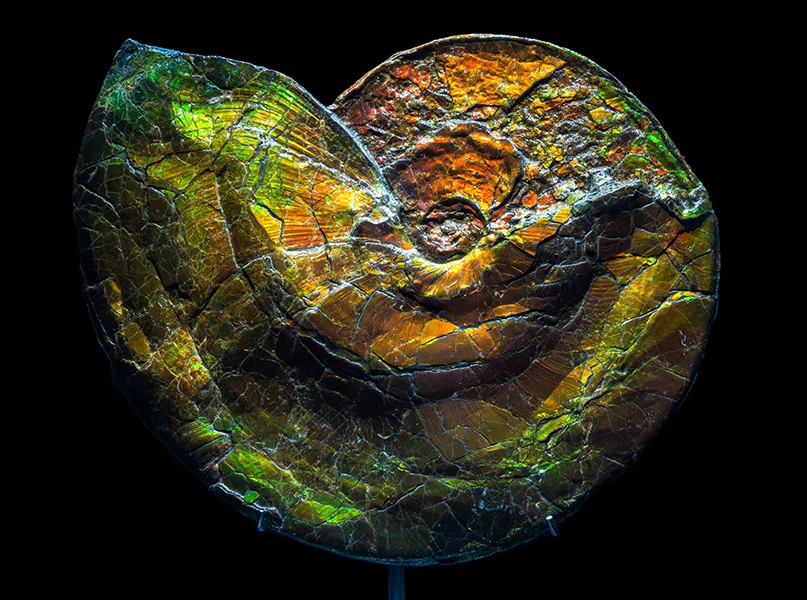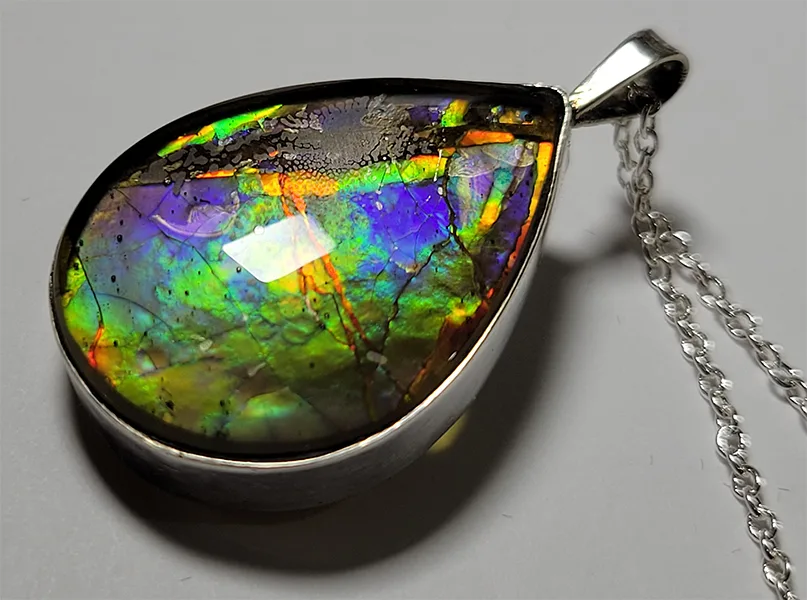We excavate the past to uncover the mysteries of ammolite. More than just a gemstone, it’s a piece of natural history that has organic origins and ethereal qualities, treasured for both its aesthetic appeal and rarity.
DIGGING DEEP INTO AMMOLITE MINING
Forged in the earth over millions of years, ammolite is a rare and highly coveted gemstone, renowned for its unique optical properties, boasting a striking spectrum of colours that ripple in mesmerising patterns, reminiscent of stained glass.
This exceptional organic material originates from the fossilised shells of ammonites – ancient spiral-shelled marine molluscs that thrived in warm, shallow seas during the Late Cretaceous period before becoming extinct alongside the dinosaurs.
During the Mesozoic era, a vast tropical sea, known as the Western Interior Seaway, covered this region. Over time, tectonic shifts raised the seabed into land, burying the ammonite remains beneath mineral-rich sediments, particularly bentonite clay.
This unique geological setting preserved the shells’ dazzling optical effects instead of converting them into calcite fossils.
Ammonite fossils are primarily located along the eastern slopes of the Rocky Mountains in North America, especially the Canadian Rockies of Alberta, Canada. Whilst they can be found worldwide, only those preserved in the sedimentary layers of Southern Alberta exhibit a vibrant iridescence characteristic of ammolite.
The gemstone is mainly composed of aragonite, the same mineral found in pearls, and is therefore akin to an eternal kaleidoscope, with metallic, iridescent flashes of colour dancing across its surface, creating a cascade of hues.
Ammolite is graded using a system similar to that used for diamonds or tanzanite, with a range from AAA to standard. Stones with a full spectrum of colours are highly valued, whilst those with fewer hues receive lower grades.
The more vivid and diverse it is, the more desirable the gemstone, captivating collectors and jewellery enthusiasts worldwide.
Ammolite is known as a one-location wonder and, like other single-source gems such as tanzanite, csarite, and larimar, its limited geographic origin only adds to its allure.
MINING MAP
The Bearpaw Formation, once part of the Bearpaw Sea in the Western Interior Seaway, stretches all the way from Alberta to Saskatchewan and Montana. However, ammolite is exclusively commercially extracted in Alberta due to the region’s superior-quality stone.
The mining process involves mechanised excavation of pits up to 100 metres (m) deep, where material is screened for gem content. Each centimetre of exposed shale is scrutinisingly examined by hand to identify ammolite.
Deposits occur in several layers, with the shallowest being the K Zone at 15 to 30 m below the surface. Here, ammolite is typically covered by siderite concretions and may be cracked and fractured during deposition. It may also have imperfections known as matrix lines, in which case the material is sometimes referred to as crush or dragon skin.

About half of mined ammolite is suitable for jewellery, with only one to 10 percent achieving the top grade.
Below this layer, the Blue Zone, extending from 20 to 65 m, features more desirable ammolite with fewer or no fractures and is characterised by being compressed with a thin layer of pyrite instead of siderite concretions. This sheet material usually contains the majority of AAA-grade ammolite, making it the most desirable and rare.
After the meticulous mining process, the extracted ammolite is stabilised with glue to prevent damage and is often backed with a sturdier material, such as black onyx or shale, to ensure durability, especially for use in jewellery.
To protect its beauty, ammolite is typically stabilised as a triplet, which consists of three layers. The thin ammolite layer is bonded to a slice of the original fossil for support and topped with a transparent layer, usually made of natural quartz. This protective coating may be faceted in various patterns, enhancing its lustre and colour play.
The value of ammolite triplets varies by size and vibrancy rather than carat weight, due to the stabilising materials.
The colours result from thin layers within the gem that reflect light rather than absorb it, as with traditional coloured stones.
Whereas thicker layers produce reds and greens, thinner layers yield blues and violets, creating a unique, shifting spectrum in every stone.
The delicate, wafer-thin layers of ammolite make transforming the substance into gemstones a complex task. Its fragility and focus on high-quality contribute to its reputation as a rare and valuable addition to jewellery and home décor.
A SACRED STONE
Long before ammolite was formally recognised as a gemstone, the Blackfoot people of Southern Alberta cherished it as a sacred emblem of spiritual strength and an enduring link to the land, depending on it for their survival.
Now believed to offer health benefits, such as detoxification and purification, and associated with energy boosts and increased stamina, it once held significant cultural importance for Indigenous peoples and is deeply connected to their folklore.
The Blackfoot tribe, originally inhabitants of the expansive Great Plains of North America – covering what is now Montana, Idaho, and Alberta – trace their roots back to
the Great Lakes region.
Over a millennium ago, a Blackfoot clan faced a harsh winter with dwindling food supplies and the threat of a tempestuous storm looming.
In desperation, they turned to prayer, during which a young woman had a vivid dream in which a spirit gave her a mystical stone and instructed her to perform a ceremonial song to summon the buffalo.
Following the symbols in her dream, she found the legendary singing stone and urged the tribe to prepare for a ceremony, hoping the buffalo might return.
As the ceremony unfolded, the anticipated storm swept in, enveloping the camp in a swirling flurry which forced many to seek shelter from the raging elements.
Miraculously, by dawn’s early light, the clan awoke to find a majestic herd of buffalo roaming near their camp. The bounteous gift reaffirmed the gem’s spiritual power, providing life-sustaining food and resources crucial to the clan’s survival through the unforgiving winter.
Today, ammolite retains its ceremonial importance amongst the Blackfoot people, often used in rituals that connect them to their ancestors and the natural world.

NATURE’S LEGACY
Since 1979, ammolite has been primarily harvested by KORITE, the preeminent producer of this extraordinary gemstone.
Commanding an impressive 95 percent of the world’s reserves, the company is celebrated not only for the exceptional quality of its ammolite but also for its unwavering commitment to ethical and sustainable mining practices.
The gemstone’s mesmerising, intricate patterns have made it a coveted choice in both the jewellery and collectables markets. Over the past 15 years, its value has soared – growing by an estimated 30 percent annually – as collectors recognise its rarity and potential as a sound investment.
With an increasing appreciation for its beauty and uniqueness in both Western and Asian markets, ammolite has emerged from the shadows to capture the attention of discerning gemstone enthusiasts worldwide. Moreover, ammolite holds a special place in feng shui, a Chinese philosophy that posits the gemstone can attract wealth and prosperity to its wearer.
Ammolite stands as a breathtaking alternative to traditional gemstones, offering a stunning visual appeal whilst being mined with a deep respect for the environment and the local communities that inhabit the areas around its extraction sites.
As such, KORITE’s operations in Calgary and near Lethbridge are situated within Treaty 7 territory, honouring the rich legacies of the Blackfoot Confederacy, the Tsuut’ina Nation, and the Métis Nation of Alberta, whilst respecting the histories and cultures of the First Peoples of Canada.
Spellbinding and sustainable, each exquisite ammolite piece is not only a work of art but also a tribute to its natural and cultural heritage, offering consumers a rare opportunity to own a remarkable piece of history.
With its unique origins and captivating beauty, ammolite not only showcases the wonders of natural history but also highlights the importance of sustainable practices in preserving this extraordinary gemstone for future generations.
ETHEREAL AMMOLITE
Ammolite has a 3.5 to four hardness rating on the Mohs scale, making it relatively soft compared to other gemstones.
Indigenous peoples, including the Blackfoot tribe, called ammolite iniskim, meaning ‘buffalo stone’.
Whilst red and green colours are standard for ammolite, blue and violet are extremely rare.
Ammolite is one of the newest gemstones in the world, officially recognised by the World Jewellery Confederation in 1981, positioning it alongside other illustrious gems such as opal, ruby, sapphire, and emerald, and affirming its status as one of the rarest treasures on Earth.





































